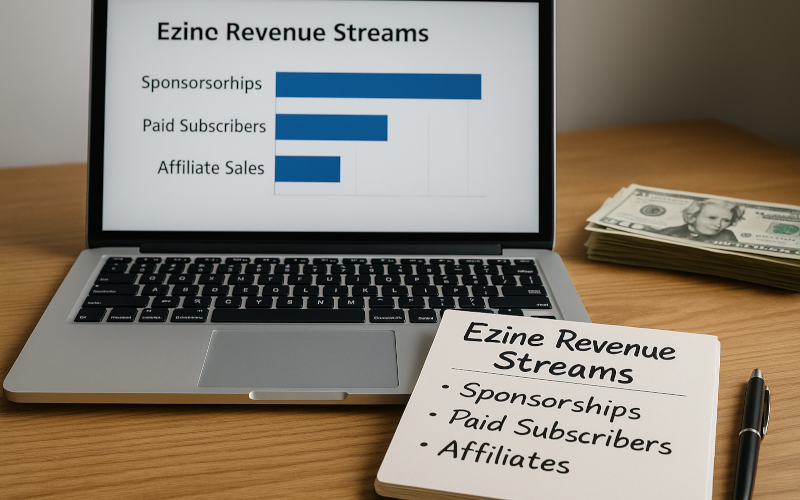Disclaimer: This post may have affiliate links. As an Amazon Associate, I earn from qualifying purchases.

How Successful Ezines Make Money: The Revenue Models That Work
Not long ago, ezines were passion projects. People wrote them for fun, often without expecting a dime in return. Fast forward to 2025, and ezines aren’t just back they’re thriving businesses.
From Morning Brew to Stratechery, newsletters are pulling in six- and seven-figure revenues. Independent creators are leaving full-time jobs to run ezines as sustainable careers.
So, how do successful ezines make money? Let’s explore the proven revenue models that keep creators profitable while maintaining reader trust.
1. Paid Subscriptions
This is the most straightforward model: charge readers for premium access.
-
How it works: Offer a free edition, then upsell to a paid tier with bonus content, deeper analysis, or exclusive perks.
-
Examples:
-
Stratechery by Ben Thompson - subscribers pay for premium daily updates.
-
Substack creators - many run “freemium” newsletters with both free and paid content.
-
📌 Tip: Readers are willing to pay if your ezine provides unique insights they can’t get elsewhere.
2. Sponsorships
Sponsorships are the backbone of many free ezines. Brands pay to be featured in your issue.
-
How it works: Sell ad slots, banner placements, or “sponsored sections.”
-
Examples:
-
Morning Brew earns millions from sponsors like Fidelity and Google.
-
The Hustle monetized primarily through sponsorships before being acquired by HubSpot.
-
📌 Tip: Match sponsors with your audience. Relevance builds trust and engagement.
3. Affiliate Marketing
Ezines can earn commissions by recommending products or services.
-
How it works: Include affiliate links in your content. If readers buy, you earn a percentage.
-
Examples:
-
Tech ezines often link to software tools.
-
Lifestyle ezines recommend books, courses, or gear.
-
📌 Tip: Only promote products you truly believe in trust is your greatest asset.
4. Digital Products and Courses
Many ezines expand into digital products.
-
How it works: Use your ezine to market e-books, courses, or workshops.
-
Examples:
-
Creators bundle newsletter archives into e-books.
-
Industry experts launch masterclasses through their ezines.
-
📌 Tip: This model works best once you’ve established authority and trust.
5. Events and Community Memberships
Ezines can extend beyond the inbox into real-world or digital communities.
-
How it works: Host paid webinars, conferences, or private groups.
-
Examples:
-
Trends by The Hustle offers a paid community alongside its newsletter.
-
Many niche ezines run members-only Slack or Discord groups.
-
📌 Tip: People pay for access, connection, and insider knowledge.
6. Hybrid Models
Most successful ezines don’t rely on a single stream they combine them.
Example hybrid stack:
-
Free tier for reach
-
Paid tier for depth
-
Sponsors for revenue
-
Digital products for scale
This layered approach builds resilience and maximizes income potential.
The Golden Rule: Trust First, Money Second
No matter the model, the most successful ezines share one principle: they never sacrifice reader trust.
Overloading issues with ads or promoting irrelevant products erodes credibility fast. Sustainable revenue comes from aligning monetization with genuine reader value.
FAQs
Q1: How many subscribers do I need to monetize?
You can start small, some creators earn from sponsorships with just 1,000–2,000 engaged readers. Paid tiers often work best with 500+ loyal subscribers.
Q2: What’s the most profitable model?
It depends. Large audiences thrive on sponsorships; niche audiences do well with paid tiers or products.
Q3: Can I mix multiple revenue streams?
Yes, and you should. Most top ezines use hybrid models to balance income.
Ezines as Sustainable Businesses
Ezines are no longer hobby projects they’re powerful, profitable platforms. From subscriptions to sponsorships, affiliates to products, there’s a model for every creator.
The key is simple: build trust, then monetize ethically.
📌 Action step: Choose one monetization model to test in your ezine this month. Even a small experiment can unlock new growth.
Authors LaunchPad - Book marketing systems and launch funnels.
Authors Book Launch - Press releases, media kits, and book launch blogs.
8Write - Writing tips and creative development resources.
ArticleDrafts - Prewritten content and ghostwriting services for authors.
MTDLN Media Group - Explore our full creator network.